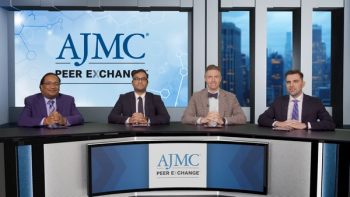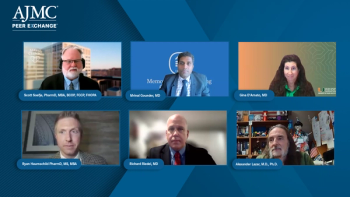
Enhancing NSCLC Management: MDT Approaches and Decisions
Experts explore strategies to increase the number of patients benefiting from multidisciplinary team (MDT) collaboration and the factors MDTs consider when deciding between surgical resection and nonsurgical options for early-stage NSCLC.
Episodes in this series

David Carbone, MD, PhD: Dr Forde, how do you increase the number of patients benefiting from MDT [multidisciplinary team]?
Patrick Forde, MBBCh: There’s a few ways of potentially doing that. We formalized our MDT now. But just before I actually started on faculty [approximately] 14 years ago, we had 1 person [who was in] charge of it [and they were] a radiation oncologist. In some ways it was helpful not having a medical oncologist in charge of it because it brought in another specialty. The other thing is making it clear to patients that this is how we discuss their cases. It then becomes an attractant for patients coming to the institution that your case will be discussed in an MDT. Some of the really practical things for the physicians and the others involved is having a time limit to discussions. Our person, Russ Hales, who runs our MDT, is very strict on time. He must have a timer someplace in the background. Practically, Zoom or whatever platform you use has made a difference; it’s almost guaranteed that there’s 1 person from each specialty, at a minimum, on the call. [But] there are downsides. You don’t get the personal interaction, but that hopefully can be facilitated in other venues apart from the MDT, which is more work focused, trying to get a practical recommendation for the patient.
David Carbone, MD, PhD: I run our MDT and we do a hybrid approach where we have some people in person and some [virtual]. I agree that you have to be very focused on being succinct and getting the information discussed that needs to get discussed, but you need to move on when the discussion is has gone around the room, so to speak. Physicians are always very invested in their patients and sometimes they like to just keep talking. You need to say, “This sounds like our recommendation. Let’s move on.” I agree, [in order] to allow the maximum number of patients to benefit from this kind of interaction. Dr Gillaspie, what considerations does the MDT evaluate when choosing between surgical resection and nonsurgical approaches for early-stage non–small cell lung cancer?
Erin A. Gillaspie, MD, MPH, FACS: There’s a few different things we’re thinking about. One of the lovely things I think all of us have mentioned in different ways is one of the big goals of the tumor boards or the [MDTs] is to make sure we’re making the right diagnosis and stage, because that’s how we’re choosing our treatments for these patients. The treating physician [should go] back to that patient to determine [the] goals [and] what [needs to be accomplished] with these therapies to make sure we’re choosing the right options. For patients [who] are [at] an appropriate stage for the consideration of surgery to be part of a single therapy or as part of a multimodal regimen, some of the things I’m thinking about for that patient are their functional status [and] how well [they’re] doing. That’s something I’m often looking at as I’m walking the patient into the room. I actually love to walk my patients in and out of clinic.
David Carbone, MD, PhD: You can see the way they walk.
Erin A. Gillaspie, MD, MPH, FACS: It tells you so much about how functional a person is. That’s exactly right. All those little pieces, you’re gathering data—thinking about their comorbid conditions or these things that we can manage. Are there risks we can mitigate? Smoking cessation is a huge piece to that. Pulmonary function testing as well, making sure that if we’re taking out a small part of lung or a big part of a lung, our patients still going to have to live a meaningful life and do all the things they want to do. Those are the things I’m running through in my mind as we’re talking about these patients and multidisciplinary tumor reports.
David Carbone, MD, PhD: Often it’s about radiation approaches, for example, and surgical approaches—both affect lung function. These are all competing approaches [for] the same patient. I just had a patient this week, a 90-year-old woman with a stage IB lung cancer that was up front, resectable, but she was very reluctant to consider surgery. It’s like Dr Forde was saying, that the medical recommendation can be one thing, but the final decision has to be the treating doc and the patients. But often today, [because] we have a lot of new modalities, new approaches, better treatment planning, [and] better minimally invasive surgical options, the same patient can be treated 2 different ways, and justifiably. If other things being equal—performance status, patient desire, all those things—were not part of the equation, where do you draw the line between the surgical neoadjuvant approach, say, and chemoradiation? A number of N2 nodes or what?
Erin A. Gillaspie, MD, MPH, FACS: It’s one of my favorite things to talk about because we could talk about it all day. If you put 5 different surgeons in a room and ask them what’s resectable—microscopic single station, microscopic multistation, bulky single station, bulky multiple stations—you’d have a different answer from every single person. The reality is we don’t have a perfect answer to that. Otherwise, every single patient would be going down a similar treatment pathway for each of those iterations. There are some inherent challenges to staging. Our staging isn’t perfect. I had a gentleman just last week who had a horrible, very proximal tumor with significant postobstructive pneumonia. His nodes lit up absolutely everywhere and we kept biopsying [all of them, and they were] all negative, negative, negative, negative, because reaction to this horrible pneumonia that we just couldn’t treat. There are all these conflicting pieces of data we’re having to sort through constantly with these patients, [which] further emphasizes the importance of bringing all our team members together. I will say I am seeing a trend toward more aggressive surgical interventions related to N2 disease, especially in the aftermath…of CheckMate 816 [NCT02998528]. We’re seeing such an extraordinary response. One of the big benefits we all talk about, and often something our radiation oncologist asks us with these patients, is [whether] additional tissue is going to make a huge difference to how we make decisions for this patient afterward? That’s a patient population [in which] surgery is going to be really helpful to actually test those nodes in a more meaningful way [and] get that tumor out so we can do additional molecular testing to truly assess the pathologic response. These are the things we have to consider when we’re putting our treatment regimens together for patients—how it’s going to affect the next steps.
David Carbone, MD, PhD: You touched on a really important point, that…the staging really drives much of this. It frustrates me that too often a stage is assumed by a little spot on a PET [positron emission tomography] scan. That little spot in a bone or somewhere that’s the only site of metastatic disease can totally transform the patient’s treatment from a curative intent to palliative intent, for example. I try very hard to document the extent of disease. It’s frustrating to me, for example, when a patient comes in with a lung mass and a little something in the liver.
Erin A. Gillaspie, MD, MPH, FACS: Yeah.
David Carbone, MD, PhD: The typical private general practitioner will send that patient to a pulmonologist because they think they have lung cancer, and the pulmonologist knows how to do a bronchoscopy and they’ll biopsy the primary lesion and often not even biopsy the media style nodes. Whereas I think the ideal way to diagnose and stage that patient is to biopsy that thing in the liver.
Erin A. Gillaspie, MD, MPH, FACS: We get diagnosis and stage.
David Carbone, MD, PhD: We get diagnosis and stage, then [patients] are often assumed to have extensive nodal involvement. I’ve seen very hot lymph nodes that are all biopsy negative. So, PET scans are not perfect. In these multidisciplinary discussions, they’re really helpful, getting your interventional pulmonologists in there, surgeons, and even [gastroenterologists, as] we’re doing more [endoscopic ultrasound–guided] biopsies as well. You really have to do the best thing for your patient. You really have to be confident of not only their diagnosis…but also about the staging so you can make the right decision for intervention. I’ve been doing lung cancer oncology since dinosaurs roamed the Earth, [and] through a lot of my training, if there was any mediastinal involvement, that would be off the table for surgery. Now with PACIFIC regimen, you combine immunotherapy with definitive chemoradiation, you’re dramatically improving outcomes with that modality, too. That’s a consistent dilemma we’re faced with in our MDTs, but at least we discuss it and we do the pros and cons of each patient’s situation and come up with a group consensus about what the right thing to do is.
Erin A. Gillaspie, MD, MPH, FACS: How much fun is it to have options? We have options.
David Carbone, MD, PhD: Lung cancer was very simple back in the old days.
Salma Jabbour, MD, FASTRO: I think the reverse is true. We’ve talked about a little bit more about advanced stage and how to think about biopsies in those situations, but also for the very early-stage patients, making sure we’re not under staging them. We have a stage I tumor, making sure that those lymph nodes in the mediastinum are truly negative, just not just because the PET said so because that would also give us to give a more intensive, preoperative regimen.
David Carbone, MD, PhD: Not all primaries are better.
Salma Jabbour, MD, FASTRO: Yes. So really getting that appropriate stage with either a discussion at the tumor board to decide on that or to send for more information with the pulmonologist.
David Carbone, MD, PhD: Beyond staging in those things, what other patient factors are considerations for eligibility for surgery?
Erin A. Gillaspie, MD, MPH, FACS: We talked a little about [pulmonary function tests], but I [also] think about cardiac status, nutritional status, [and] smoking status. You really need to have a good understanding of comorbid conditions. I always like to meet a patient before determining respectability. It’s really hard to get a complete picture over a Zoom conference or hearing someone else describe it, so it’s really common for someone to call me and I just run over to their clinic quickly to see a patient.
David Carbone, MD, PhD: Walk them up a flight of stairs.
Erin A. Gillaspie, MD, MPH, FACS: That’s exactly right. Run around with me for a little while, and
I’ll see how it goes. But it makes a huge difference and I think it adds a lot of richness to the conversations and decision-making.
Salma Jabbour, MD, FASTRO: [Another] important factor I also like to consider in the clinic as a radiation oncologist is [the] support the patient [has]. Not every patient will have support, family, or friends to aid with treatment. But I would like to know that, because then my interventions may be more geared to help the patient through the course of their therapy. Understanding what resources the patient may or may not have is a way that the medical team can help them more if needed.
Transcript is AI-generated and edited for clarity and readability.
Newsletter
Stay ahead of policy, cost, and value—subscribe to AJMC for expert insights at the intersection of clinical care and health economics.






































